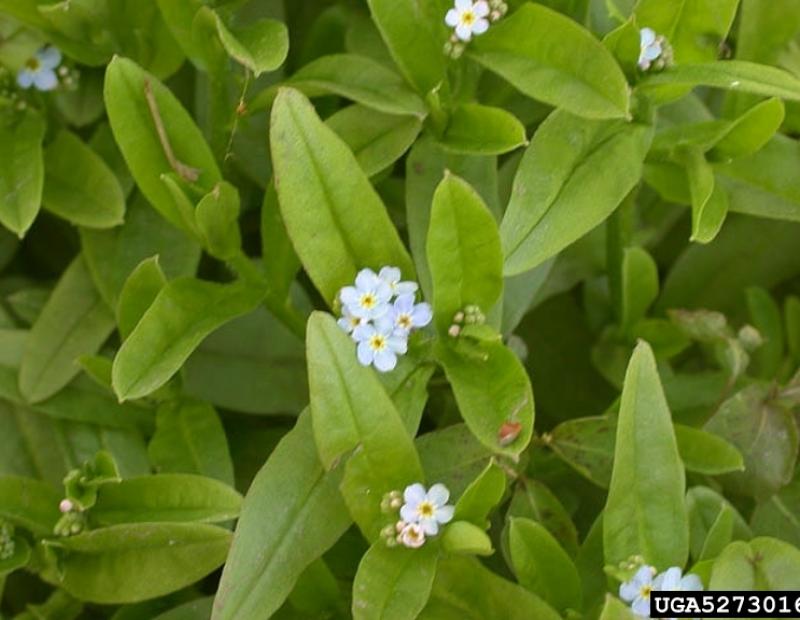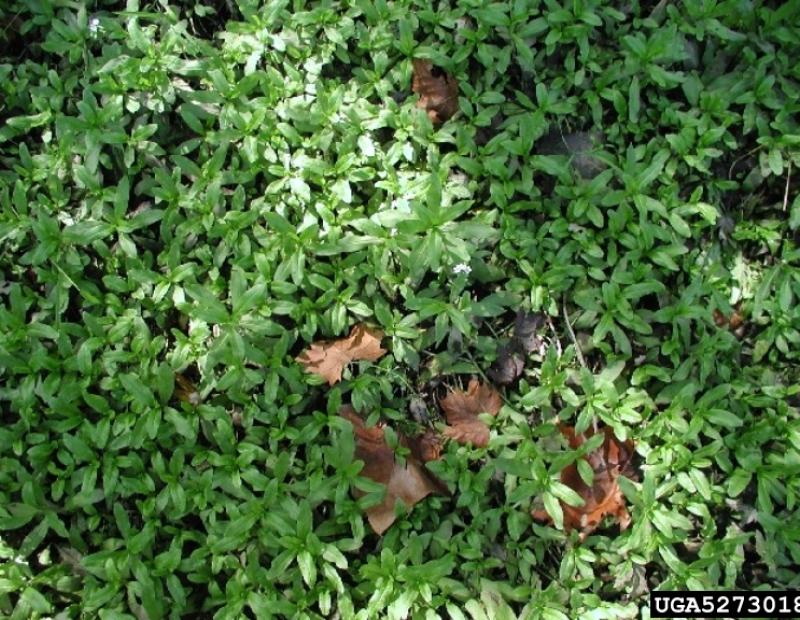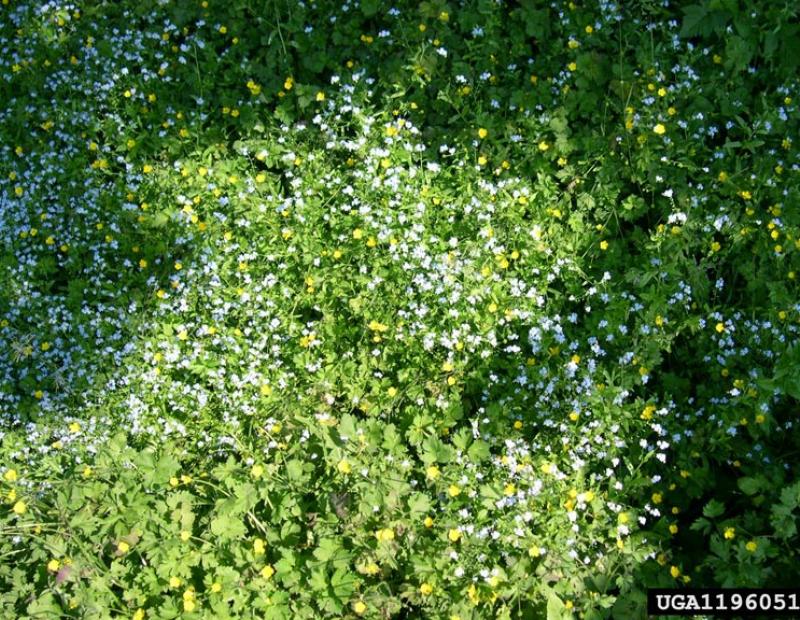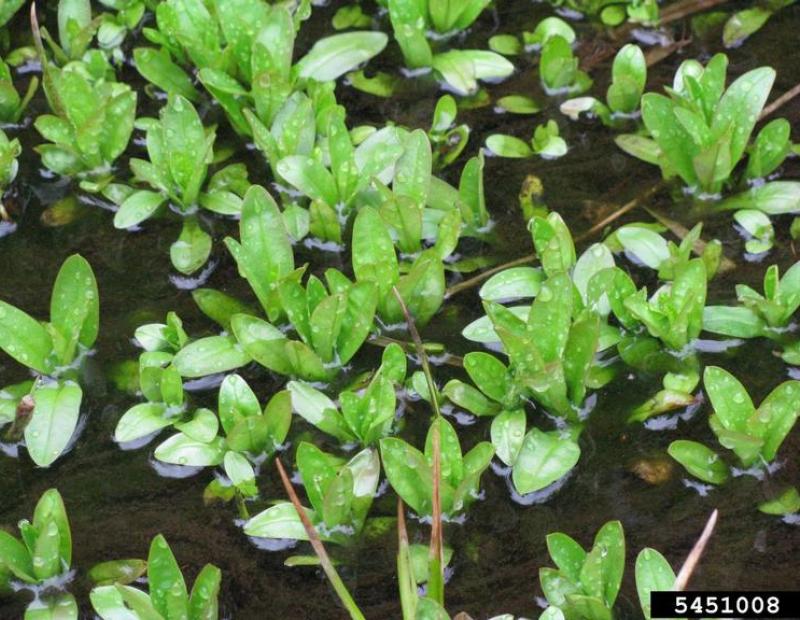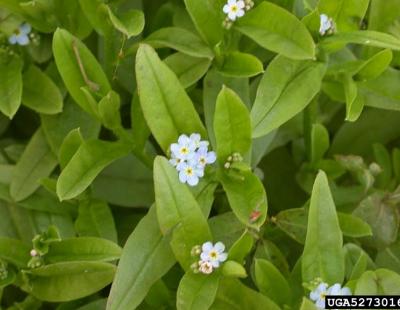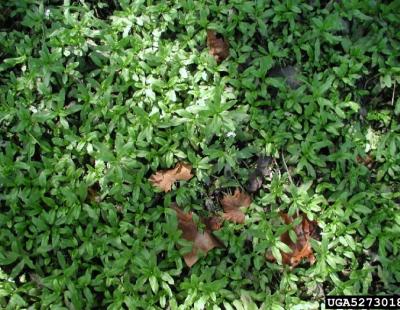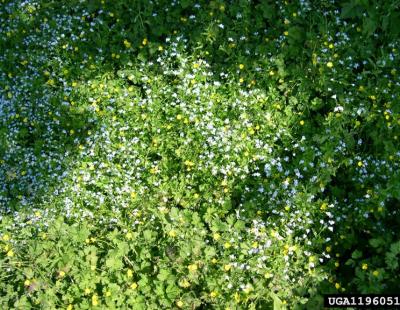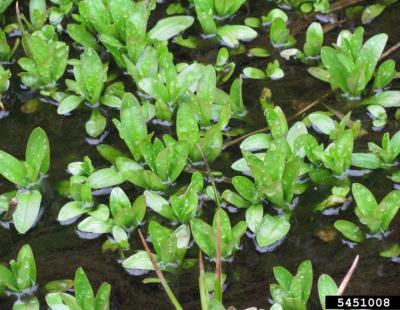Vertical Tabs
- True forget-me-not is a member of the Borage family (Boraginaceae)
- An attractive, erect to creeping, rhizomatous perennial occupying marshy ground, stream banks and wetlands, true forget me not is most easily recognized in late spring, when a profusion of small pink and blue flowers open at the end of coiled, scorpion tail-like stems. (2)
Leaves
Leaves are bright green, somewhat shiny, alternately arranged, simple, and with smooth margins. (2)
Flowers
Flowers are blue and sometimes pink, approximately ¼” in diameter, 5 petaled, and open at the end of stems which slowly uncoil as the flowers bloom. (3)
Little research has been conducted on the invasive potential and ecological impacts of true forget-me-not. The species’ ability to spread rapidly via rooting stolons enables dense, homogenous stands to form quickly, outcompeting other native plants and changing the structure and diversity of the habitats it colonizes. (7, 8).
Biological Control
There is currently no single optimal biological control agent in use against this species.
Manual or Mechanical Control
Pulling / Digging Up: Pulling by hand is an effective method of control as long as care is taken to remove all of the root. Pull before seed set to minimize germination in subsequent years. (7)
Mowing: Not advisable. True forget me not generally colonizes wet areas where heavy equipment would be inoperable.
Girdling: Not applicable
Prescribed Fire: Not applicable. Areas infested with True forget-me-not are generally too wet for controlled burns.
Prescribed Grazing: Not advisable. True forget-me-not contains alkaloid components toxic to many grazers. (6)
Soil Tilling: Not advisable. Tilling will fragment roots and stems and could encourage re-sprouting. True forget-me-not grows on moist, fragile sites prone to erosion.
Mulching: No information available.
Solarization: No information available.
Hot Foam Spray: No information available.
Chemical Control
The pesticide application rates and usage herein are recommendations based on research and interviews with land managers. When considering the use of pesticides, it is your responsibility to fully understand the laws, regulations and best practices required to apply pesticides in a responsible manner. At times, the pest you seek to treat may not be on a pesticide label, requiring a 2ee exemption from NYSDEC. Always thoroughly read the label of any pesticide and consult the NYSDEC or a licensed pesticide applicator with questions.
Foliar Spray: Very little research has been done on chemical treatment of True forget-me-not. However, a 1% solution of glyphosate is effective at managing related species although repeat applications may be necessary. Infestations managed in this way should be revisited in 2-3 weeks to monitor for regrowth. Always read and follow all instructions on the herbicide label.(8)
Cut Stump: Not applicable
Basal Bark: Not applicable
Hack-And-Squirt
Stem Injection: Not applicable
Pre-Emergent Spray: Not applicable
General management overview and recommendation
Little research has been conducted on best management practices of true forget-me-not. As with any other invasive infestation complex, large swaths of true forget-me-not are likely best managed via a combination of mechanical and chemical means. All managed infestations should be monitored to ensure exhaustion of the seed bank and to prevent reinvasion from nearby populations. Any new seedlings can be hand pulled or sprayed.
Post treatment monitoring
Any infestations managed by chemical means must be revisited in 2-3 weeks to check for treatment efficacy. Infestations managed solely by mechanical or physical means will need consistent follow up treatment to manage re-sprouting. Due to the species tendency to colonize wet, potentially fragile soils, managed infestations should be intentionally revegetated and monitored for future seedling emergence.
Disposal Methods
Waste material can be composted so long as management was completed prior to seed set. Any seed heads must be bagged and disposed of. All rooting stolons must be thoroughly dried and or crushed.
REFERENCES
- https://www.eddmaps.org/ipane/ipanespecies/herbs/Myosotis_scorpioides.htm
- https://gobotany.newenglandwild.org/species/myosotis/scorpioides/
- http://www.missouribotanicalgarden.org/PlantFinder/PlantFinderDetails.as...
- Mehrhoff, L.J., J.A. Silander, Jr., S.A. Leicht and E. Mosher. 2003. IPANE: Invasive Plant Atlas of New England. Department of Ecology and Evolutionary Biology, University of Connecticut, Storrs, CT.
- http://accs.uaa.alaska.edu/files/invasive-species/Myosotis_scorpioides_B...
- https://www.researchgate.net/publication/223214375_Seed_deposition_in_dr...
- https://dnr.wi.gov/topic/Invasives/fact/AquaticForgetMeNot.html
- http://wric.ucdavis.edu/information/natural%20areas/wr_M/Myosotis.pdf

